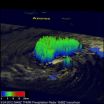(Press-News.org) Nearly two weeks after becoming a tropical storm in the central Atlantic back on September 11th, NASA satellites confirm that Nadine is still spinning away south of the Azores as a minimal tropical storm. One of those satellites called TRMM has been providing forecasters with rainfall rates and cloud heights.
Nadine initially formed into a tropical depression from an African easterly wave that had propagated westward out into the central Atlantic from the coast of Africa. Nadine initially moved northwestward then northward before getting caught up in the westerlies over the north-central Atlantic on Sept. 15. It was there that Nadine became a minimal hurricane as it moved due east. After two days, Nadine turned to the northeast in the direction of the Azores and weakened back to a tropical storm. Nadine slowed down as it approached the Azores and became almost stationary on Sept. 20 about 150 miles (~240 km) southwest of the islands. Nadine than began moving just south of due east again then finally southward away from the islands. At this point, Nadine lost some of its tropical characteristics as convection died out around the center, and it was declared post-tropical by the National Hurricane Center. A day and a half later on Sept. 23, Nadine regained some of its thunderstorm activity and was declared a tropical storm again. By now, Nadine was well south of the Azores and beginning to move westward again.
The Tropical Rainfall Measuring Mission (TRMM) satellite has been keeping tabs on Nadine in the central Atlantic. TRMM captured an image of Nadine on the morning of the September 24 after Nadine had again become a tropical storm. The image taken at 08:49 UTC (4:49 pm EDT) September 24, provided a look into the structure of Nadine by way of the storm's rain pattern.
The TRMM imagery is created at NASA's Goddard Space Flight Center in Greenbelt, Md. To make the images of rainfall, rain rates in the center of the image are created from the TRMM Precipitation Radar (PR), while those in the outer swath are from the TRMM Microwave Imager (TMI). The rain rates are then overlaid on infrared (IR) data from the TRMM Visible Infrared Scanner (VIRS).
The TRMM imagery showed that Nadine's cyclonic circulation is clearly evident in the swirling cloud elements (visible in white) as they spiral in towards the center in a counter clockwise direction. In terms of rainfall, Nadine is very asymmetric with nearly all of the rain contained in a rainband north of the center (shown in green, indicating moderate rain).Right near the center, there were some smaller areas of rain present (shown in blue, indicating light rain), but nothing significant that would indicate Nadine is preparing to intensify.
In fact, Nadine had been and continues to experience some southwesterly wind shear and dry air. Combined with marginal sea surface temperatures, it is not an environment conducive for development. However, conditions are forecast to become more favorable in a couple of days and Nadine could become a little stronger.
On Sept. 25, at 5 a.m. EDT (0900 UTC0, Nadine's maximum sustained winds were near 45 mph (75 kmh) with higher gusts. The National Hurricane Center expects some slow strengthening over the next two days. The center of Tropical Storm Nadine was located near latitude 32.1 north and longitude 29.6 west. Nadine is moving toward the west near 6 mph (9kmh) and a turn toward the southwest with a reduction in forward speed is expected later today, followed by a turn to the south on Wednesday, Sept. 26. Nadine's estimated minimum central pressure is 996 millibars.
Despite its relatively long life, Nadine has a ways to go before capturing the record. Hurricane Ginger was around for 27 days back in 1971, and the 1899 Puerto Rico Hurricane lasted 28 days as a tropical cyclone.
INFORMATION:
TRMM is a joint mission between NASA and the Japanese space agency JAXA.
NASA satellites see Tropical Storm Nadine 'refuse to go away'
2012-09-26
ELSE PRESS RELEASES FROM THIS DATE:
Mouse pancreatic stem cells successfully differentiate into insulin producing cells
2012-09-26
Tampa, Fla. (Sep. 25, 2012) – In a study to investigate how transplanted islet cells can differentiate and mature into insulin-producing pancreatic cells, a team of Japanese researchers found that using a specific set of transcription factors (proteins that bind to specific DNA sequences) could be transduced into mouse pancreatic stem cells (mPSCs) using Sendai virus (SeV), a mouse influenza virus, as a carrier, or vector.
The study is published in a recent issue of Cell Medicine [3(1)], now freely available on-line at: http://www.ingentaconnect.com/content/cog/cm.
"Diabetes ...
NASA infrared data compares Super Typhoon Jelawat with Tropical Storm Ewiniar
2012-09-26
NASA's Aqua satellite has been obtaining infrared, visible and other data everytime it passes over Typhoon Jelawat and Tropical Storm Ewiniar in the western North Pacific, and a combination of two images from Aqua's AIRS satellite puts the storms in perspective.
A combined image created from infrared data obtained by the Atmospheric Infrared Sounder (AIRS) instrument that flies on NASA's Aqua satellite provides a comparison of the two monster storms in the western North Pacific Ocean basin . An infrared image of Typhoon Jelawat captured on Sept. 25 was combined with an ...
Category 2 Hurricane Miriam Seen in East Pacific by NASA satellite
2012-09-26
The MODIS instrument that flies aboard NASA's Aqua and Terra satellites provide some of the most clear and stunning imagery of tropical cyclones, and captured a visible image of Category 2 hurricane Miriam off the western coast of Mexico.
MODIS stands for the Moderate Resolution Imaging Spectroradiometer. Terra's MODIS and Aqua's MODIS view the entire Earth's surface every 1 to 2 days, acquiring data in 36 spectral bands, or groups of wavelengths. NASA's Aqua satellite flew over Hurricane Miriam on Sept. 24 at 21:00 UTC and the MODIS instrument captured a visible image ...
Hubble goes to the eXtreme to assemble farthest-ever view of the universe
2012-09-26
Like photographers assembling a portfolio of best shots, astronomers have assembled a new, improved portrait of mankind's deepest-ever view of the universe.
Called the eXtreme Deep Field, or XDF, the photo was assembled by combining 10 years of NASA Hubble Space Telescope photographs taken of a patch of sky at the center of the original Hubble Ultra Deep Field. The XDF is a small fraction of the angular diameter of the full moon.
The Hubble Ultra Deep Field is an image of a small area of space in the constellation Fornax, created using Hubble Space Telescope data from ...
Lunar Reconnaissance Orbiter explores the Moon in 3-D
2012-09-26
Scientists using the camera aboard NASA's Lunar Reconnaissance Orbiter are acquiring stereo images of the moon in high resolution (0.5 to 2 meters/pixel) that provide 3-D views of the surface from which high resolution topographic maps are made. The Lunar Reconnaissance Orbiter Camera Narrow Angle Camera (LROC NAC) team from the University of Arizona and Arizona State University are currently developing a processing system to automatically generate anaglyphs from most of these stereo pairs. An anaglyph is an image that can be viewed in 3-D using red-blue/green glasses.
LROC ...
Compelling evidence that brain parts evolve independently
2012-09-26
An Evolutionary Biologist at The University of Manchester, working with scientists in the United States, has found compelling evidence that parts of the brain can evolve independently from each other. It's hoped the findings will significantly advance our understanding of the brain.
The unique 15 year study with researchers at the University of Tennessee and Harvard Medical School also identified several genetic loci that control the size of different brain parts.
The aim of the research was to find out if different parts of the brain can respond independently of each ...
Inner city infants have different patterns of viral respiratory illness than infants in the suburbs
2012-09-26
Children living in low-income urban areas appear especially prone to developing asthma, possibly related to infections they acquire early in life. In a new study in The Journal of Infectious Diseases, available online, researchers from the University of Wisconsin in Madison investigated viral respiratory illnesses and their possible role in the development of asthma in urban versus suburban babies. The differences in viral illness patterns they found provide insights that could help guide the development of new asthma treatments in children.
Viral respiratory illnesses ...
PowerStone Property Management Announces Key New Hires And Promotes 3
2012-09-26
PowerStone Property Management Inc. a full service Orange County, California based property management firm, today announced that it has added several new employees and promoted 3 managers. The announcement was made by CEO Rene Decker. "We're very excited to add such a high caliber of people to our team who are attracted to PowerStone because of our solid reputation and phenomenal growth." He adds, "Every gain we make also allows us to promote from within. I'm especially pleased with the way our company culture is evolving."
New hires include Amanda ...
EVM2812 TI DSP Evaluation Board for Motion Control System
2012-09-26
EVM2812 TI DSP Evaluation Board for Motion Control System
Toronto, Canada ¨C GAO Tek Inc. (www.GAOTek.com) is offering its EVM2812 TI DSP evaluation board which has a 32-bit fixed-point Flash DSP operating at 150 MHz. This evaluation board is specially optimized for motor driving and control systems.
This EVM2812 TI DSP evaluation board, model B0M10002, is based on the MS320F2812 series DSPs. It features on-chip flash program memory, on-chip and extendable SRAM and extendable EEPROM. This module forms a complete digital servo motion control system by interfacing with ...
iFlow Yoga Introduces Immersion Retreats & Teacher Training in Ubud, Bali
2012-09-26
iflow Yoga Immersion Retreats & Teacher Training, a Registered Yoga School, will be held for the first time in Bali, Indonesia, between February 17 - March 19, 2013. Located at the Melatti Cottages in Ubud, Bali, four one-week Modules will be offered for those who are new to yoga as well as seasoned practitioners looking to immerse themselves in a retreat setting for seven days of yoga.
Module 1 of the iflow Yoga Immersion Retreats & Teacher Training will take place beginning February 17 - 23, 2013, and is offered to anyone including those new to yoga. Module ...



